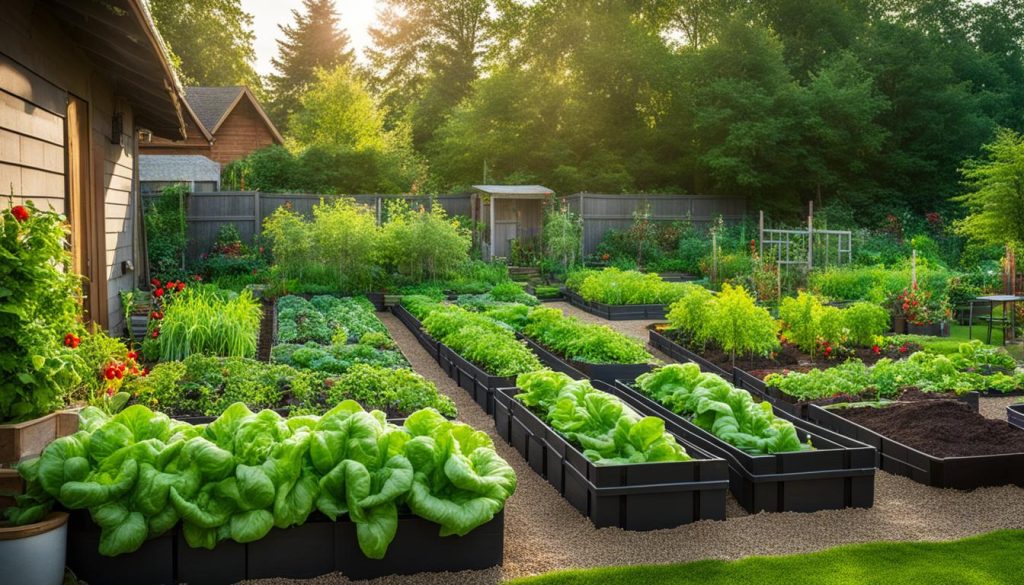Welcome to our guide on the joys and benefits of vegetable garden landscaping in your Canadian backyard. With a sustainable vegetable garden, not only will you enhance the beauty of your landscape, but you’ll also enjoy the taste of homegrown produce.
At Landscape Designer, we believe that a vegetable garden is more than just a plot of land; it’s a sustainable, eco-friendly and healthy lifestyle choice.
When you choose to incorporate a sustainable vegetable garden in your landscape, you’re joining a growing community of gardeners who care about the environment and their health.
Throughout this guide, we’ll explore the importance of vegetable garden landscaping, designing a thriving vegetable garden, selecting the perfect vegetables for your Canadian garden, implementing sustainable practices, maintaining your garden year-round, and harvesting and enjoying the fruits of your labor.
So let’s get started and create a beautiful and sustainable vegetable garden in your Canadian backyard!
The Importance of Vegetable Garden Landscaping
Welcome to our discussion on the importance of vegetable garden landscaping in creating a sustainable garden in your Canadian backyard. At Landscape Designer, we believe that incorporating a vegetable garden in your landscape design is not only visually appealing but also environmentally and health-wise beneficial.
By creating a beautiful and thriving vegetable garden, you can reduce your carbon footprint and improve air quality. Additionally, growing your own organic vegetables in a sustainable manner offers numerous health benefits, such as providing fresh and nutritious food for you and your family, reducing your exposure to harmful chemicals found in conventional produce, and enhancing your overall well-being.
At Landscape Designer, we’re passionate about helping you achieve a sustainable and beautiful vegetable garden landscape that you can enjoy for years to come.
Reducing Carbon Footprint and Improving Air Quality
Reducing your carbon footprint and improving air quality are two critical environmental benefits of incorporating a vegetable garden into your landscape design. By growing your own produce, you can significantly reduce the amount of carbon emissions through transportation and packaging required to bring fruits and vegetables from conventional farms to your local grocery store.
Furthermore, the absorption of carbon dioxide by plants in your vegetable garden can help to mitigate the impact of climate change. In addition, plants absorb a wide range of air pollutants, including nitrogen dioxide, ozone, and particulate matter, thereby improving the air quality around your home.
Growing Your Own Organic Vegetables in a Sustainable Manner
Growing your own vegetables in a sustainable manner allows you to take control of what goes into your food. You can eliminate synthetic pesticides and fertilizers and use organic and natural methods to protect your plants from pests and diseases. As a result, you can have peace of mind knowing that you’re providing fresh and healthy produce for you and your family.
In addition, by using sustainable gardening practices such as composting, water conservation, natural pest control, and companion planting, you can create a self-sustaining ecosystem in your vegetable garden. This allows you to minimize your reliance on harmful chemicals and maintain a healthy and eco-friendly garden.
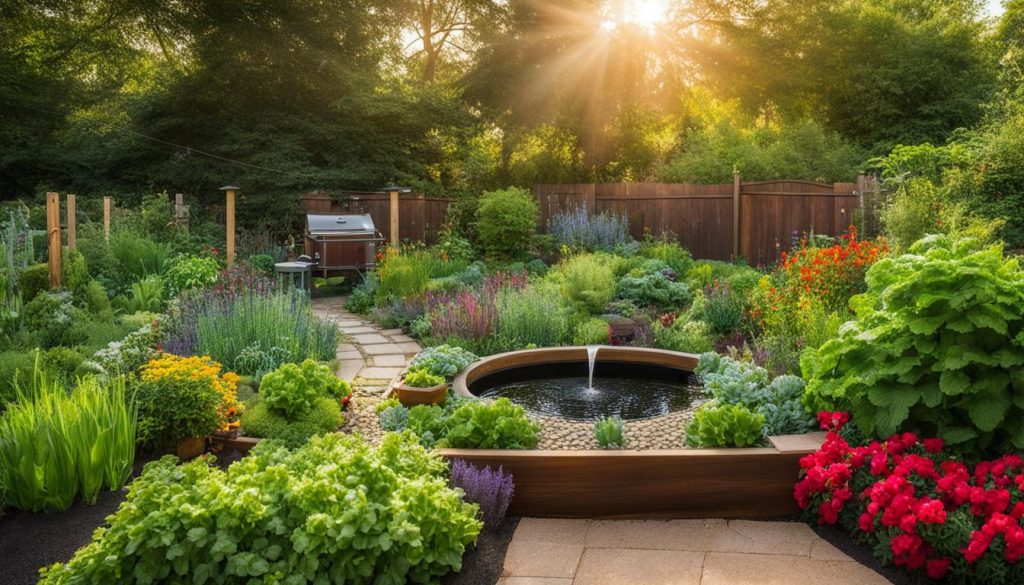
Ready to start your vegetable garden landscaping journey? Let’s work together at Landscape Designer to create the perfect sustainable garden for your Canadian backyard. Give us a call at (647) 812-8497 or visit our website at https://www.landscape-designer.ca/ to learn more about our services and view our portfolio.
Designing Your Vegetable Garden
Creating a vegetable garden that is not only visually appealing but also sustainable requires careful planning and thoughtful design. Here, we’ll guide you through the key elements of designing a vegetable garden that seamlessly blends with your existing landscape.
Layout: The layout of your vegetable garden is critical to its success. Consider the size of your backyard, the amount of sunlight and shade, and the location of any existing trees, shrubs, or structures. Your garden should be easily accessible and provide enough space for your plants to grow and thrive. Use a garden planner tool or consult with a professional landscape designer to create your dream layout and ensure optimal results.
Soil Preparation: The soil is the foundation of your vegetable garden and must be prepared correctly. Test the pH level of your soil and amend it as needed with organic matter or fertilizers. Remove any rocks, weeds, or debris and till the soil to aerate it, making it easier for the roots of your plants to penetrate the soil and grow deeper.
Plant Selection: Choosing the right plants is crucial to the success of your vegetable garden. Consider the climate in your area, the average temperature, and the length of your growing season, as well as the soil conditions. Select plants that are well-suited to these factors and that complement one another in terms of growth and pest control. When designing your garden, take into account the height and spacing of your plants to ensure they have enough room to mature and produce edible fruits and vegetables.
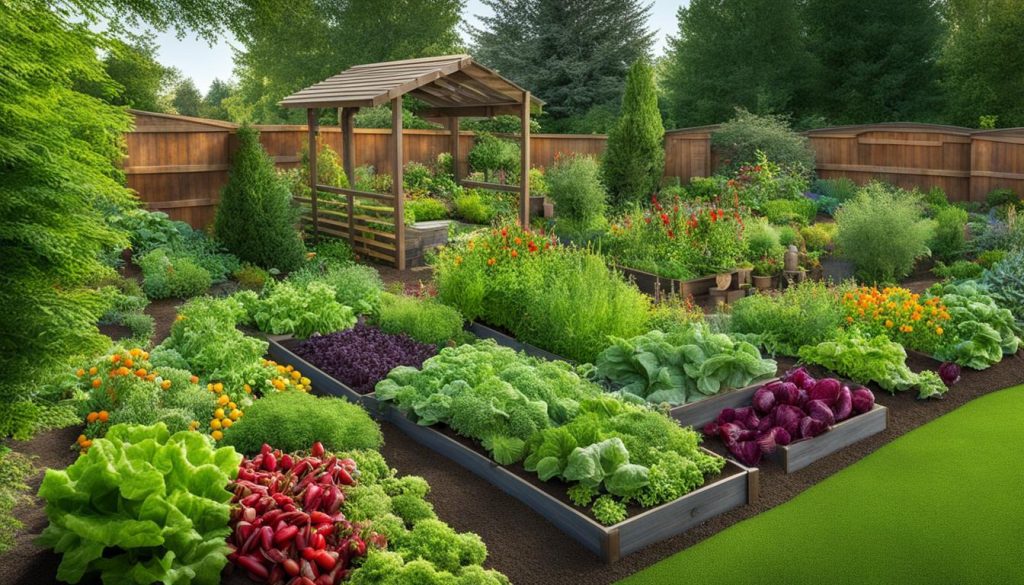
- Companion Planting: Companion planting is the practice of growing certain plants together that complement or protect one another. For example, marigolds and nasturtiums can help repel pests, while beans and peas can fix nitrogen in the soil, reducing the need for fertilizers.
- Vertical Gardening: If you have limited space or want to add height and dimension to your garden, consider vertical gardening. Trellises, stakes, and cages can be used to train vine plants like tomatoes or cucumbers to grow upwards, saving space and increasing yields.
By incorporating these key elements into your vegetable garden design, you can create a sustainable and visually stunning addition to your Canadian backyard that provides healthy and delicious food for you and your family to enjoy.
Selecting the Perfect Vegetables for Your Canadian Garden
When it comes to selecting vegetables for your Canadian garden, it’s essential to choose varieties that are well suited to your climate, soil, and sunlight conditions. This will ensure that your vegetable garden thrives and produces an abundant harvest. Here are some vegetable options that are perfect for your sustainable garden in your Canadian backyard:
Tomatoes
Tomatoes are a popular choice for Canadian vegetable gardeners, and for a good reason. They are easy to cultivate, require little maintenance, and produce a bountiful harvest. Some of the best varieties for Canadian gardens include ‘Beefsteak’, ‘Celebrity’, and ‘Sun Gold’.
Carrots
Carrots are an excellent option for Canadian vegetable gardens, as they do well in cooler temperatures and moist soil. They’re also incredibly versatile in the kitchen and are a great source of nutrition. Look for varieties like ‘Scarlet Nantes’, ‘Danvers’, and ‘Chantenay’.
Peppers
Peppers are a fantastic addition to any Canadian vegetable garden, thanks to their bright colors and delicious flavors. They require a lot of sunlight and heat, so it’s best to plant them after the last frost has passed. Some popular varieties for Canadian gardens include ‘Jalapeno’, ‘Green Bell’, and ‘Cayenne’.
Lettuce
Lettuce is a cool-season vegetable that thrives in the spring and fall in Canada. They’re easy to grow and come in a variety of colors and textures, making them a visually appealing addition to any vegetable garden. Some great varieties for Canadian gardens include ‘Buttercrunch’, ‘Romaine’, and ‘Arugula’.
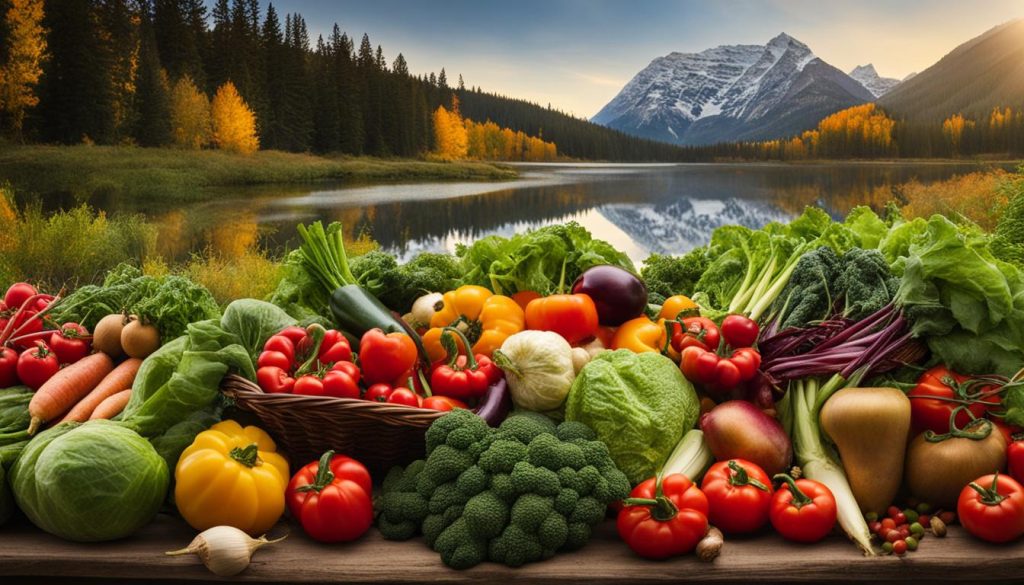
These vegetables are just a few examples of the many options available for your Canadian vegetable garden. Remember to consider the climate, soil, and sunlight conditions in your area when selecting your plants. With the right choices, you’ll be able to enjoy a bountiful harvest of fresh, delicious, and sustainable produce from your very own backyard.
Implementing Sustainable Practices in Your Vegetable Garden
At Landscape Designer, we are committed to helping you create a sustainable garden that not only enhances the beauty of your Canadian backyard but also benefits the environment. That’s why we encourage the implementation of sustainable practices in your vegetable garden. By doing so, you can reduce waste, conserve water, and create a self-sustaining ecosystem that promotes the growth of healthy and thriving plants.
Composting
One of the easiest and most effective ways to implement sustainable practices in your vegetable garden is through composting. Composting is the process of breaking down organic matter, such as food waste, yard trimmings, and leaves, into rich soil that can be used to nourish your vegetable plants. By composting, you can reduce the amount of waste that goes to landfills and create nutrient-rich soil for your garden. To get started, simply create a compost pile in your backyard and add organic matter regularly. To ensure optimal composting, keep a balance of “green” (fresh) and “brown” (dry) materials, and maintain proper moisture levels.
Water Conservation
Water is a precious resource that should be conserved, especially in areas prone to drought. In your vegetable garden, there are several ways you can conserve water. For instance, you can use a drip irrigation system that delivers water directly to the roots of your plants, minimizing evaporation. You can also mulch around your plants with biodegradable materials, such as straw or wood chips, to retain moisture in the soil. Additionally, you can collect rainwater in a barrel and use it to water your plants during dry periods.
Natural Pest Control
Pests are a common problem in vegetable gardens, but using chemical pesticides can harm the environment and your health. Instead, try using natural pest control methods to keep pests at bay. For instance, you can introduce beneficial insects, such as ladybugs and praying mantises, that feed on harmful pests. You can also plant herbs, such as basil and rosemary, which repel pests with their aromatic oils. Additionally, you can use physical barriers, such as row covers or netting, to prevent pests from accessing your plants.
Companion Planting
Companion planting is the practice of planting different crops together that benefit each other in some way. For instance, you can plant herbs, such as sage and thyme, with your vegetables to repel pests and promote healthy growth. You can also plant nitrogen-fixing plants, such as beans and peas, that add nutrients to the soil. By incorporating companion planting in your vegetable garden, you can create a diverse ecosystem that supports the growth of healthy and thriving plants.
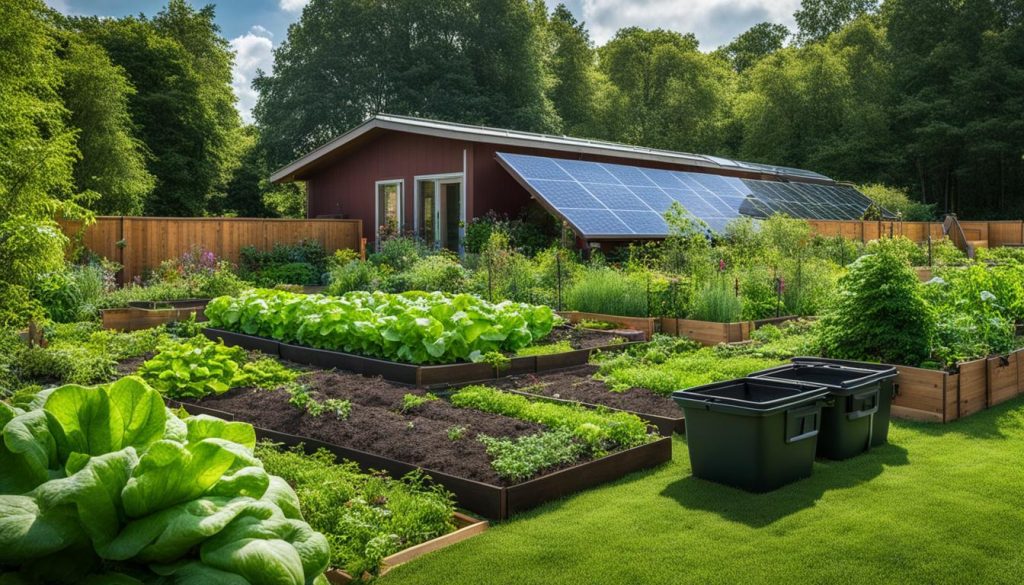
Implementing sustainable practices in your vegetable garden can benefit both your health and the environment. At Landscape Designer, we can help you create a beautiful and sustainable garden that reflects your unique style and meets your specific needs. Contact us today at (647) 812-8497 to learn more about our services and how we can transform your Canadian backyard into a haven of fresh, homegrown goodness.
Maintaining Your Vegetable Garden Year-Round
At Landscape Designer, we believe that maintaining a vegetable garden year-round is crucial for sustainable garden landscaping in your Canadian backyard. It ensures that your garden is always healthy and ready to produce delicious, homegrown vegetables. Here are some tips to maintain your garden throughout the year:
Pruning and Fertilization
Regular pruning is essential for the health of your plants. It helps to remove diseased or damaged branches, increase air circulation, and promote new growth. We recommend pruning your plants in late winter or early spring before new growth begins.
Fertilization is also essential for a healthy garden. We suggest using organic fertilizers to avoid damaging the environment and to promote healthy soil. It is best to fertilize your plants in the early spring to provide the necessary nutrients for the growing season.
Protecting Your Garden in the Winter
Canadian winters can be harsh, so it is crucial to protect your garden from the cold temperatures, snow, and ice. We recommend covering your garden with mulch or straw to provide insulation and protect the roots from freezing. You can also use frost blankets or row covers to cover your plants.
Watering Your Garden
Watering is essential for a healthy garden, but it is crucial to avoid overwatering. We suggest watering your garden deeply once a week and avoiding overhead watering, as it can lead to fungal diseases. It is also best to water your garden in the early morning or late evening to avoid evaporation during the hot summer months.
Natural Pest Control
Pest control is a necessary part of maintaining a healthy garden, but it is crucial to avoid using harmful chemicals that can damage the environment. We suggest using natural pest control methods such as companion planting, crop rotation, and beneficial insects like ladybugs and praying mantises. These methods are safe and effective at controlling pests and promoting a healthy garden ecosystem.
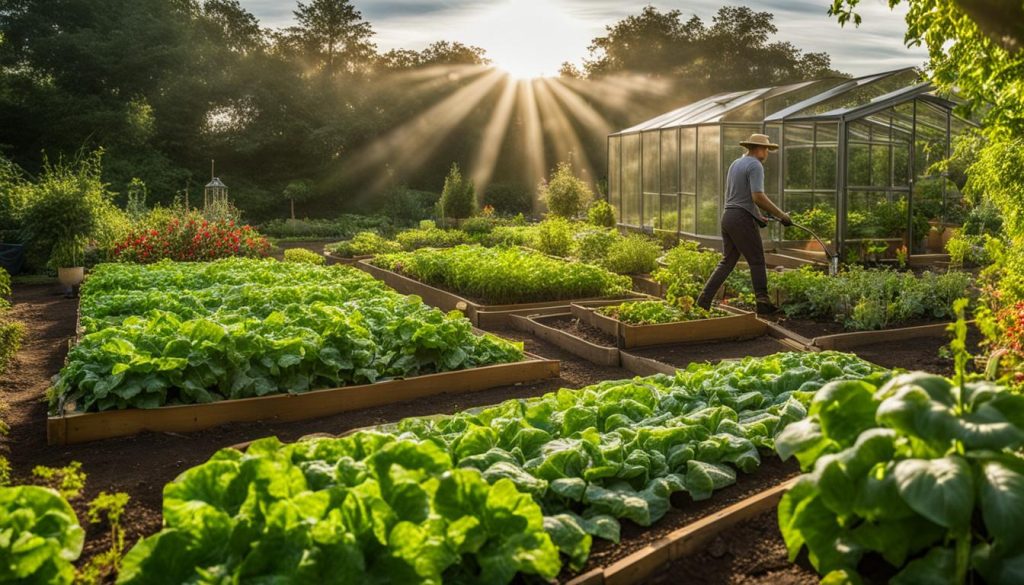
With these tips, you can successfully maintain your vegetable garden year-round and ensure a bountiful harvest of delicious, homegrown vegetables. At Landscape Designer, we believe in creating sustainable gardens that enhance the beauty of your Canadian backyard while providing a source of fresh, healthy produce.
Harvesting and Enjoying the Fruits of Your Labor
Congratulations! You’ve put in the hard work and dedication to create a beautiful and sustainable vegetable garden in your Canadian backyard. Now, it’s time to reap the rewards and enjoy the delicious flavors of your homegrown produce.
When it comes to harvesting your vegetables, timing is key. Different vegetables have different optimal harvesting times, so it’s important to do your research and know when to pick your crops. For example, tomatoes are best when fully ripe and have a deep color, while leafy greens like lettuce and spinach should be harvested when young and tender.
Once you’ve harvested your vegetables, there are a variety of ways to enjoy them. From classic recipes like tomato sauce and stir-fry to more unique creations like zucchini bread and beet hummus, the possibilities are endless.
Don’t forget about preservation techniques for extending the shelf life of your harvest. Canning, pickling, and freezing are great options for making your vegetables last beyond the growing season.
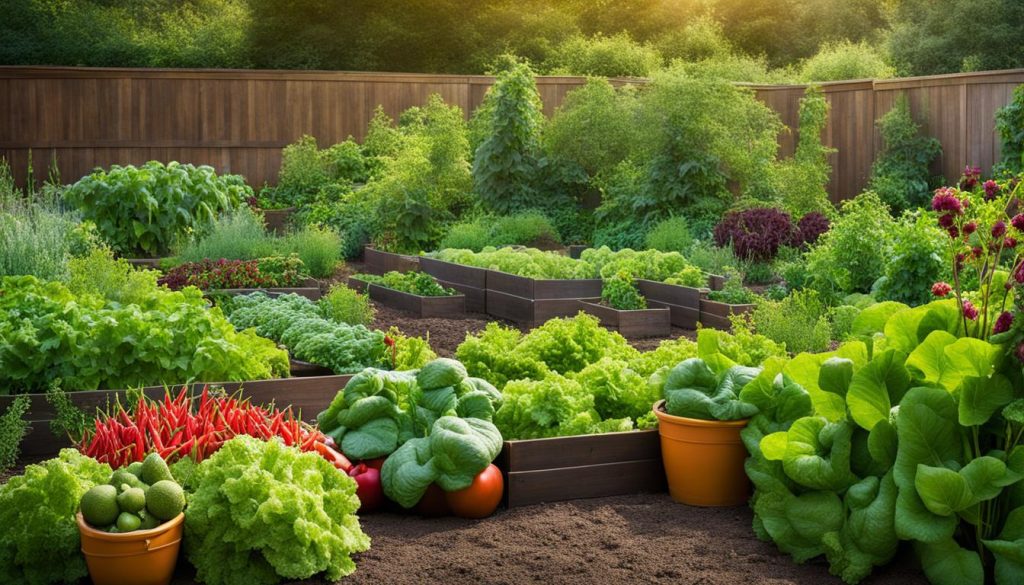
Maximizing your harvest is also important to ensure you get the most out of your hard work. Consider sharing your bounty with friends and family, or donating to a local food bank.
At the end of the day, enjoying the fruits of your labor is what makes the hard work of vegetable garden landscaping worth it. So sit back, relax, and savor the taste of your fresh, homegrown vegetables.
Bringing It All Together with Landscape Designer
At Landscape Designer, we believe that a sustainable vegetable garden is not only a beautiful addition to your Canadian backyard, but also a source of pride and joy. We are passionate about helping our clients create thriving, eco-friendly gardens that provide an abundance of fresh, organic produce year-round.
Our Services
As experienced landscape designers, we offer a range of services that cater to your unique needs and preferences. From initial consultation and design to installation and ongoing maintenance, we work with you every step of the way to ensure a seamless and stress-free experience.
Our team of experts specializes in creating custom vegetable garden landscaping solutions that are tailored to your specific location and climate. We take pride in designing visually stunning gardens that not only look great but also enhance the natural beauty of your Canadian backyard.
Our Portfolio
At Landscape Designer, we take pride in our extensive portfolio of beautifully designed and sustainable gardens. Our designs are inspired by the natural beauty of Canada and are tailored to suit a wide range of preferences and budgets.
Whether you prefer a traditional garden with raised beds and heirloom vegetables or a modern garden with cutting-edge features such as rainwater harvesting and vertical gardens, we can help you bring your dream garden to life.
FAQ
What are the benefits of creating a sustainable vegetable garden in my Canadian backyard?
Creating a sustainable vegetable garden not only enhances the beauty of your landscape but also allows you to enjoy the taste of homegrown produce. It provides you with a fresh and healthy food source, reduces your carbon footprint, improves air quality, and promotes a sense of self-sufficiency.
Why is vegetable garden landscaping important?
Vegetable garden landscaping is important because it allows you to incorporate sustainable practices into your overall landscape design. It helps improve the environment by reducing reliance on industrial agriculture, promotes healthier eating habits, and adds aesthetic value to your Canadian backyard.
What are the key elements of designing a vegetable garden?
When designing a vegetable garden, it is important to consider the layout, soil preparation, and plant selection. A well-designed vegetable garden should have proper spacing between plants, adequate sunlight exposure, and fertile soil enriched with organic matter. It should also consider factors such as water availability and potential pest issues.
How do I choose the right vegetables for my Canadian garden?
To select the perfect vegetables for your Canadian garden, consider the climate and growing conditions in your region. Choose plant varieties that are well-suited to your specific area, taking into account factors such as temperature, soil type, and average frost dates. It is also helpful to research the maintenance requirements and yield potential of different vegetable varieties.
What sustainable practices can I implement in my vegetable garden?
There are several sustainable practices you can implement in your vegetable garden, such as composting organic waste, using natural pest control methods, conserving water through efficient irrigation systems, and practicing companion planting. These practices help minimize the use of harmful chemicals, reduce waste, and create a balanced and self-sustaining garden ecosystem.
How do I maintain my vegetable garden throughout the year?
To maintain your vegetable garden year-round, it is important to regularly water, weed, and fertilize your plants. Prune and stake plants as needed to support healthy growth. Protect your garden from harsh Canadian winters by using mulch or row covers, and consider extending the growing season with the use of cold frames or greenhouses.
How can I make the most of my harvest from the vegetable garden?
To make the most of your harvest from the vegetable garden, explore diverse recipes that showcase the flavors of your homegrown produce. Consider preserving excess vegetables through canning, freezing, or pickling. Plan meals and share the abundance with friends, family, or local food banks, ensuring that nothing goes to waste.
How can Landscape Designer help me create the perfect vegetable garden landscape?
Landscape Designer is your trusted partner in creating the perfect vegetable garden landscape. Our team of experts can assist you with designing and implementing a sustainable garden that meets your specific needs and aligns with your Canadian backyard.

